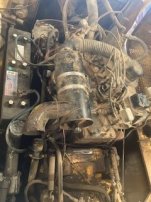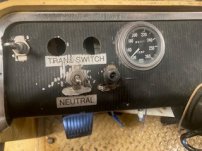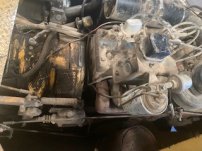Palak
Aluminum
- Joined
- Jul 12, 2013
- Location
- Pacific NW
We just purchased a 54 year old Hyster S80B forklift. We got it from a guy that purchased it at auction, but it didn't suit his needs, as it has hard tires and he needed something for dirt. It appears to have had a former life in a wood working plant, as the engine bay was/is filthy with fine dust.
The forklift works . . . okay. It is LPG powered, and starts up right away. The steering is very heavy, and is more like "herding" than steering. The brakes seem to be pretty bad. And it leaks hydraulic fluid, but we haven't yet determined from which cylinders (has 2-stage lift, backtilt, and sideshift). We only need the forklift for maybe 10-hrs a year, mostly moving machines around and loading/unloading the occasional truck. It was cheap and convenient, and we hope to add more years of productive life to old girl.
Right now, not sure how well she has been taken care of, and from preliminary checkup, some of the fluids don't register on the dipsticks, so we are not starting her up until we get all the lubrication and fluids up to date. She is a 1969 model -- we were able to find a service manual for this model, but the manual doesn't have great pictures or schematics, so we are hoping that you guys could help us out to make sure she gets the proper care. I will try to get pictures attached so you can see what we're dealing with.
The engine is a Continental F226 engine. I am not a mechanic, but know my way around general maintenance of an engine.
Questions:
1. The fluids that need to be changed or topped off, that I can identify, include motor oil, hydraulic oil, transmission oil, radiator coolant, and brake fluid? Anything else? Can's see any grease nipples, but are there typically areas to be greased on a forklift?
2. Can't 100% confirm that we know where the transmission fluid fill port is. There is a large dip stick/cap on the front right side of the bay, but no markings. Is this where trans fluid should be added?
3. She has a monotrol pedal. And I think that means it has a "power shift" transmission. However, the service manual only stipulates recommended transmission fluid for standard transmission (SAE 90 EP), and Hystamatic and Torque Converter ( Dexron ATF). If power shift the same as Hystamatic?
4. There are two fluid filters -- a Napa 1050 filter (for oil I think), and a 1068 filter next to the dipstick. This looks like it might filter transmission fluid? Can anyone confirm?
5. The brakes don't seem to work well. Assume it could be due to low fluid in master cylinder. Should I just open up large bolt on master cylinder, and add until full?
6. Hyster manual says to flush oil with "flushing oil". Is this still a thing? I saw elsewhere on internet that Hyster recommends adding seafoam as flushing agent. Anyone have experience with this?
7. Saw something about adding oil to felt wick in distributor and on "breaker arm pivot"?
8. Finally, it looks like there are a few gauges removed and switches added to the dashboard. One switch is broken off, and the old label says "brake" under it. Any idea what this could be?
Sorry for the wall of text. Appreciate any and all comments and help to make sure we don't add any additional wear and tear to the old girl.
The forklift works . . . okay. It is LPG powered, and starts up right away. The steering is very heavy, and is more like "herding" than steering. The brakes seem to be pretty bad. And it leaks hydraulic fluid, but we haven't yet determined from which cylinders (has 2-stage lift, backtilt, and sideshift). We only need the forklift for maybe 10-hrs a year, mostly moving machines around and loading/unloading the occasional truck. It was cheap and convenient, and we hope to add more years of productive life to old girl.
Right now, not sure how well she has been taken care of, and from preliminary checkup, some of the fluids don't register on the dipsticks, so we are not starting her up until we get all the lubrication and fluids up to date. She is a 1969 model -- we were able to find a service manual for this model, but the manual doesn't have great pictures or schematics, so we are hoping that you guys could help us out to make sure she gets the proper care. I will try to get pictures attached so you can see what we're dealing with.
The engine is a Continental F226 engine. I am not a mechanic, but know my way around general maintenance of an engine.
Questions:
1. The fluids that need to be changed or topped off, that I can identify, include motor oil, hydraulic oil, transmission oil, radiator coolant, and brake fluid? Anything else? Can's see any grease nipples, but are there typically areas to be greased on a forklift?
2. Can't 100% confirm that we know where the transmission fluid fill port is. There is a large dip stick/cap on the front right side of the bay, but no markings. Is this where trans fluid should be added?
3. She has a monotrol pedal. And I think that means it has a "power shift" transmission. However, the service manual only stipulates recommended transmission fluid for standard transmission (SAE 90 EP), and Hystamatic and Torque Converter ( Dexron ATF). If power shift the same as Hystamatic?
4. There are two fluid filters -- a Napa 1050 filter (for oil I think), and a 1068 filter next to the dipstick. This looks like it might filter transmission fluid? Can anyone confirm?
5. The brakes don't seem to work well. Assume it could be due to low fluid in master cylinder. Should I just open up large bolt on master cylinder, and add until full?
6. Hyster manual says to flush oil with "flushing oil". Is this still a thing? I saw elsewhere on internet that Hyster recommends adding seafoam as flushing agent. Anyone have experience with this?
7. Saw something about adding oil to felt wick in distributor and on "breaker arm pivot"?
8. Finally, it looks like there are a few gauges removed and switches added to the dashboard. One switch is broken off, and the old label says "brake" under it. Any idea what this could be?
Sorry for the wall of text. Appreciate any and all comments and help to make sure we don't add any additional wear and tear to the old girl.




